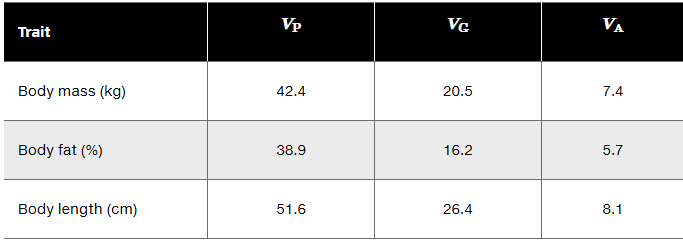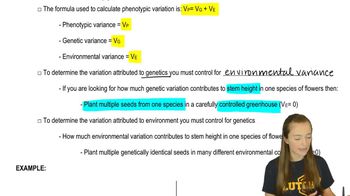In a population of 100 inbred, genotypically identical rice plants, variance for grain yield is 4.67. What is the heritability for yield? Would you advise a rice breeder to improve yield in this strain of rice plants by selection?
Table of contents
- 1. Introduction to Genetics51m
- 2. Mendel's Laws of Inheritance3h 37m
- 3. Extensions to Mendelian Inheritance2h 41m
- 4. Genetic Mapping and Linkage2h 28m
- 5. Genetics of Bacteria and Viruses1h 21m
- 6. Chromosomal Variation1h 48m
- 7. DNA and Chromosome Structure56m
- 8. DNA Replication1h 10m
- 9. Mitosis and Meiosis1h 34m
- 10. Transcription1h 0m
- 11. Translation58m
- 12. Gene Regulation in Prokaryotes1h 19m
- 13. Gene Regulation in Eukaryotes44m
- 14. Genetic Control of Development44m
- 15. Genomes and Genomics1h 50m
- 16. Transposable Elements47m
- 17. Mutation, Repair, and Recombination1h 6m
- 18. Molecular Genetic Tools19m
- 19. Cancer Genetics29m
- 20. Quantitative Genetics1h 26m
- 21. Population Genetics50m
- 22. Evolutionary Genetics29m
20. Quantitative Genetics
Heritability
Problem 23b
Textbook Question
New Zealand lamb breeders measure the following variance values for their herd.

How would you characterize the potential response to selection (R) for each trait?
 Verified step by step guidance
Verified step by step guidance1
Understand the components of variance given: VP is the phenotypic variance, VG is the genetic variance, and VA is the additive genetic variance. The additive genetic variance (VA) is most important for predicting response to selection because it represents the heritable portion of genetic variance.
Calculate the narrow-sense heritability (h²) for each trait using the formula: . This value indicates the proportion of phenotypic variance that is due to additive genetic variance.
Interpret the heritability values: higher h² means a greater potential response to selection because more of the trait variation is heritable and can be passed on to offspring.
Use the breeder's equation to understand the response to selection: , where R is the response to selection and S is the selection differential. Although S is not given, knowing h² allows you to predict the relative potential for response among traits.
Compare the heritability values for body mass, body fat, and body length to characterize which trait is likely to respond most effectively to selection based on their additive genetic variance relative to phenotypic variance.
 Verified video answer for a similar problem:
Verified video answer for a similar problem:This video solution was recommended by our tutors as helpful for the problem above
Video duration:
2mPlay a video:
Was this helpful?
Key Concepts
Here are the essential concepts you must grasp in order to answer the question correctly.
Phenotypic Variance (VP)
Phenotypic variance (VP) represents the total observed variation in a trait within a population, combining both genetic and environmental influences. It is the sum of genetic variance (VG) and environmental variance (VE). Understanding VP is essential to assess how much variation is available for selection.
Recommended video:
Guided course

Analyzing Trait Variance
Additive Genetic Variance (VA)
Additive genetic variance (VA) is the portion of genetic variance that contributes to the resemblance between parents and offspring. It reflects the cumulative effect of individual alleles and is crucial for predicting the response to selection, as only VA directly influences the trait's heritability and evolutionary change.
Recommended video:
Guided course

Traits and Variance
Response to Selection (R) and Heritability
The response to selection (R) quantifies the expected change in a trait after selection and depends on the trait's heritability (h² = VA/VP) and the selection differential. Traits with higher heritability and additive genetic variance typically show greater potential for improvement through selective breeding.
Recommended video:
Guided course

Artificial Selection

 7:04m
7:04mWatch next
Master Calculating Heritability with a bite sized video explanation from Kylia
Start learningRelated Videos
Related Practice
Textbook Question
659
views
